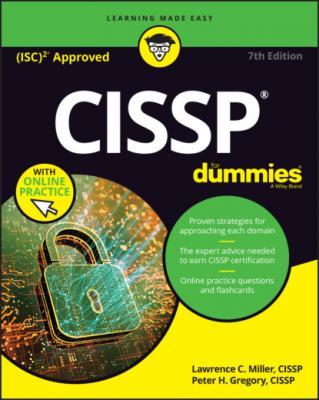CISSP For Dummies. Peter H. Gregory
Чтение книги онлайн.
Читать онлайн книгу CISSP For Dummies - Peter H. Gregory страница 11
 but always appreciated, and we sure hope that you’ll appreciate these tips! This icon flags helpful suggestions and tidbits of useful information that may save you some time and headaches.
but always appreciated, and we sure hope that you’ll appreciate these tips! This icon flags helpful suggestions and tidbits of useful information that may save you some time and headaches.
Beyond the Book
In addition to what you’re reading right now, this book comes with a free, access-anywhere Cheat Sheet that includes tips to help you prepare for the CISSP exam and your date with destiny (your exam day). To get this Cheat Sheet, simply go to www.dummies.com and type CISSP For Dummies Cheat Sheet in the Search box.
You also get access to hundreds of practice CISSP exam questions, as well as dozens of flash cards. Use the exam questions to identify specific topics and domains that you may need to spend a little more time studying and to become familiar with the types of questions you’ll encounter on the CISSP exam (including multiple-choice, drag-and-drop, and hotspot). To gain access to the online practice, all you have to do is register. Just follow these simple steps:
1 Register your book or e-book at Dummies.com to get your personal identification number (PIN).Go to www.dummies.com/go/getaccess.
2 Choose your product from the drop-down list on that page.
3 Follow the prompts to validate your product.
4 Check your email for a confirmation message that includes your PIN and instructions for logging in.If you don’t receive this email within two hours, please check your spam folder before contacting us through our support website at http://support.wiley.com or by phone at +1 (877) 762-2974.
Now you’re ready to go! You can come back to the practice material as often as you want. Simply log in with the username and password you created during your initial login; you don’t need to enter the access code a second time.
Your registration is good for one year from the day you activate your PIN.
Where to Go from Here
If you don’t know where you’re going, any chapter will get you there, but Chapter 1 may be a good place to start. If you see a particular topic that piques your interest, however, feel free to jump ahead to that chapter. Each chapter is individually wrapped (but not packaged for individual sale) and written to stand on its own, so feel free to start reading anywhere and skip around! Read this book in any order that suits you (though we don’t recommend upside down or backward).
Part 1
Getting Started with CISSP Certification
IN THIS PART …
Get acquainted with (ISC)2 and the CISSP certification.
Advance your security career as a CISSP.
Chapter 1
(ISC)2 and the CISSP Certification
IN THIS CHAPTER
In this chapter, you get to know the (ISC)2 and learn about the CISSP certification, including professional requirements, how to study for the exam, how to get registered, what to expect during the exam, and (of course) what to expect after you pass the CISSP exam!
About (ISC)2 and the CISSP Certification
The International Information System Security Certification Consortium (ISC)2 (https://www.isc2.org) was established in 1989 as a not-for-profit, tax-exempt corporation chartered for the explicit purpose of developing a standardized security curriculum and administering an information security certification process for security professionals worldwide. In 1994, the Certified Information Systems Security Professional (CISSP) credential was launched.
The CISSP was the first information security credential accredited by the American National Standards Institute (ANSI) to the ISO/IEC 17024 standard. This international standard helps ensure that personnel certification processes define specific competencies and identify required knowledge, skills, and personal attributes. It also requires examinations to be independently administered and designed to properly test a candidate’s competence for the certification. This process helps a certification gain industry acceptance and credibility as more than just a marketing tool for certain vendor-specific certifications (a widespread criticism that has diminished the popularity of many vendor certifications over the years).
The CISSP certification is based on a Common Body of Knowledge (CBK) identified by the (ISC)2 and defined through eight distinct domains:
Security and Risk Management
Asset Security
Security Architecture and Engineering
Communication